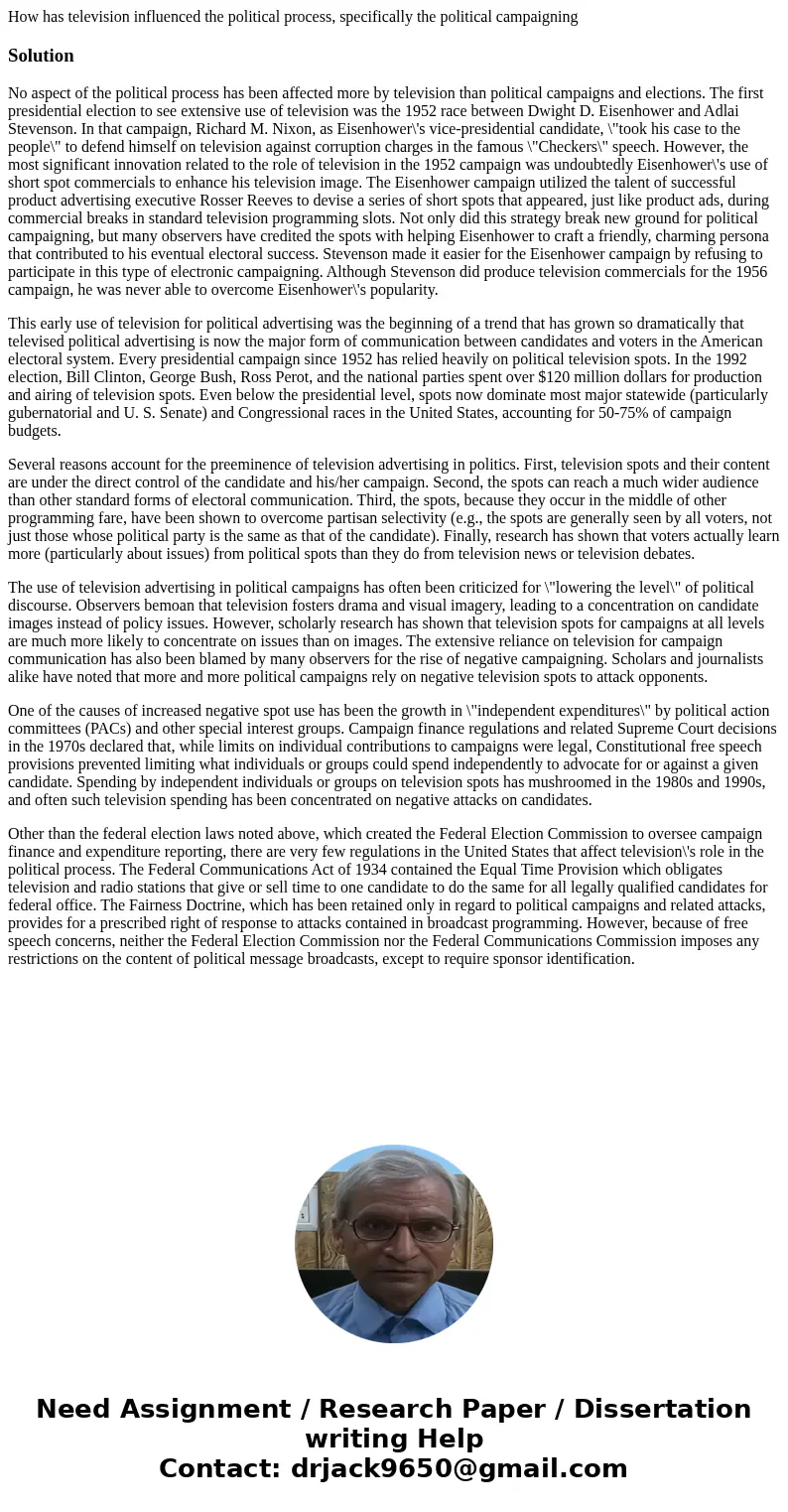How has television influenced the political process specific
How has television influenced the political process, specifically the political campaigning
Solution
No aspect of the political process has been affected more by television than political campaigns and elections. The first presidential election to see extensive use of television was the 1952 race between Dwight D. Eisenhower and Adlai Stevenson. In that campaign, Richard M. Nixon, as Eisenhower\'s vice-presidential candidate, \"took his case to the people\" to defend himself on television against corruption charges in the famous \"Checkers\" speech. However, the most significant innovation related to the role of television in the 1952 campaign was undoubtedly Eisenhower\'s use of short spot commercials to enhance his television image. The Eisenhower campaign utilized the talent of successful product advertising executive Rosser Reeves to devise a series of short spots that appeared, just like product ads, during commercial breaks in standard television programming slots. Not only did this strategy break new ground for political campaigning, but many observers have credited the spots with helping Eisenhower to craft a friendly, charming persona that contributed to his eventual electoral success. Stevenson made it easier for the Eisenhower campaign by refusing to participate in this type of electronic campaigning. Although Stevenson did produce television commercials for the 1956 campaign, he was never able to overcome Eisenhower\'s popularity.
This early use of television for political advertising was the beginning of a trend that has grown so dramatically that televised political advertising is now the major form of communication between candidates and voters in the American electoral system. Every presidential campaign since 1952 has relied heavily on political television spots. In the 1992 election, Bill Clinton, George Bush, Ross Perot, and the national parties spent over $120 million dollars for production and airing of television spots. Even below the presidential level, spots now dominate most major statewide (particularly gubernatorial and U. S. Senate) and Congressional races in the United States, accounting for 50-75% of campaign budgets.
Several reasons account for the preeminence of television advertising in politics. First, television spots and their content are under the direct control of the candidate and his/her campaign. Second, the spots can reach a much wider audience than other standard forms of electoral communication. Third, the spots, because they occur in the middle of other programming fare, have been shown to overcome partisan selectivity (e.g., the spots are generally seen by all voters, not just those whose political party is the same as that of the candidate). Finally, research has shown that voters actually learn more (particularly about issues) from political spots than they do from television news or television debates.
The use of television advertising in political campaigns has often been criticized for \"lowering the level\" of political discourse. Observers bemoan that television fosters drama and visual imagery, leading to a concentration on candidate images instead of policy issues. However, scholarly research has shown that television spots for campaigns at all levels are much more likely to concentrate on issues than on images. The extensive reliance on television for campaign communication has also been blamed by many observers for the rise of negative campaigning. Scholars and journalists alike have noted that more and more political campaigns rely on negative television spots to attack opponents.
One of the causes of increased negative spot use has been the growth in \"independent expenditures\" by political action committees (PACs) and other special interest groups. Campaign finance regulations and related Supreme Court decisions in the 1970s declared that, while limits on individual contributions to campaigns were legal, Constitutional free speech provisions prevented limiting what individuals or groups could spend independently to advocate for or against a given candidate. Spending by independent individuals or groups on television spots has mushroomed in the 1980s and 1990s, and often such television spending has been concentrated on negative attacks on candidates.
Other than the federal election laws noted above, which created the Federal Election Commission to oversee campaign finance and expenditure reporting, there are very few regulations in the United States that affect television\'s role in the political process. The Federal Communications Act of 1934 contained the Equal Time Provision which obligates television and radio stations that give or sell time to one candidate to do the same for all legally qualified candidates for federal office. The Fairness Doctrine, which has been retained only in regard to political campaigns and related attacks, provides for a prescribed right of response to attacks contained in broadcast programming. However, because of free speech concerns, neither the Federal Election Commission nor the Federal Communications Commission imposes any restrictions on the content of political message broadcasts, except to require sponsor identification.

 Homework Sourse
Homework Sourse